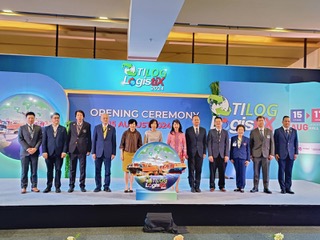For a trade fair such as this year’s “TILOG-LOGISTIX” innovation is the main character. Each of the companies with their respective booths aims to out-innovate one another, which is undoubtedly very healthy for the industry.
Thailand’s Department of International Trade Promotion (DITP), Ministry of Commerce, together with RX Tradex, recently held an annual event that features services and technologies from over 160 companies, presenting 415 brands from 25 countries plus over 20 conference sessions at the Bangkok International Trade & Exhibition Centre (BITEC). The event, with the theme “Connecting the Logistics Future” attracted over 9,000 visitors.
Aside from innovation, there are also the matters of digitalization and sustainability. This is according to Varaporn Dhamcharee, Managing Director of RX Tradex.
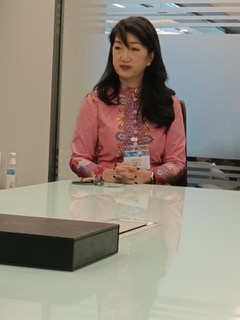
She explains, “There is evolution in all the three areas. But if you ask me to pin down one specific highlight, I would probably point to the innovation showcase.” She cites how their EV or electric vehicles are becoming staples in the industry. “We’ve collaborated with a Japanese brand, Denso, with these fully electric trucks that are made in Thailand which can be charged with any system around the country.” A smaller, fully electric truck was flown from Germany. “The container at the back of the truck is fully flexible — to accommodate any kind of products that we deliver, maximizing space as well. And of course, there are the energy-saving features and everything that comes with the EV technology.”
The third pillar is sustainability.
Nattapume Pavaratn, Senior Vice President of SCGJWD Logistics says, “We have to accept that logistics is one of the industries that emit a lot of carbon. So, there’s been a lot of talk within the community of the logistics members on how to deliver goods and services — sustainably. We’re not just talking about, ‘Oh, okay, we can buy carbon offset…’ and then that’s done. But what would be the smarter way to reduce carbon? You have the multiple-pronged approach: backhauling, EV trucks, AI solutions that help maximize the routing, and every little component combined that will go into totality of the whole supply chain. And how do people in the logistics community manage sustainability for the industry and also for the world.”
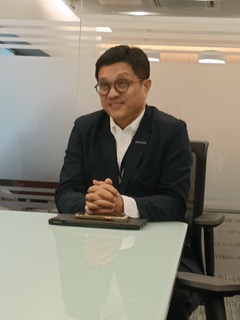
There’s also the aspect of AI in the logistics industry and how it was showcased in the expo.
“I think AI now actually touches all industries, but specifically for logistics. In the booths, we see a lot of use in AI technology. I think the most tangible one that is closer to us and we can visualize how to manage is the truck routing.” This involves monitoring the drivers for road safety as well as keeping track of inventories in the warehouse and maximizing space.
Nowadays, AI technology can be applied to everything in the logistics sector, every touchpoint.
Nattapume amplifies several points about AI.
“One application is in process improvement in terms of invoicing, billing, correcting, invoice, checking the invoice, P.O., dealing order. I think AI can replace the manual check and manual dispute. This is being implemented already in most of the logistics companies — especially SCGJWD Logistics.” But it ultimately comes down to machine learning: standardizing each aspect throughout the supply chain. “We do aim for the AI application to reduce, reuse, and also optimize the entire process.”
In terms of addressing the challenges of digitalization in Southeast Asia, Nattapume explains:
“There are different policies and infrastructure in each country — in terms of the technology, the platform, the software, and the regulation in each country. Take transport, for example. We talk about the engine, the fuel, Euro 5, Euro 7 standards are different for each country. Same with the infrastructure for the EV trucks, the charging stations, as well as the GPS system regulations in each country. We do not have one single system to check across countries in Asia. The ASEAN countries need to simplify and standardize (these elements).”
He also points out the challenges in acquiring funding for digitization and implementation of AI technology. Another challenge involves the bureaucracy.
“Logistic companies have to deal with different standards for regulations in terms of cold storage, freight loading, and chemical logistics. It’s mainly about the different variations of licenses and the way of doing business in each country.”
A conference such as TILOG-LOGISTIX brings all these issues to light as well as to connect the various players in the logistics industry.

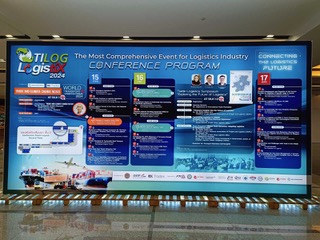

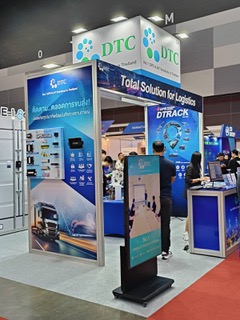
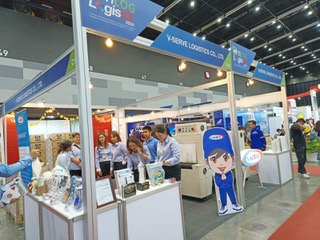
Varaporn explains, “This is an exhibition that not only connects people in the logistics community together, but also builds business opportunities. Whether it’s businesses from other countries that want to connect and build the network in Thailand or vice versa. If you notice, we have the business-matching lounge and business-matching services. For the exhibitors and visitors who come together in this show to connect — not just to buy and sell products, but to also network and probably build a business partnership. And then that leads to more business opportunities.
EV, AI, reducing carbon footprint…. These are more than just buzzwords or phrases. The key for the participants of the conference is to come up with real drivers of change that offer immense potential for growth and transformation. The ongoing dialogue and partnerships formed at this exhibition will undoubtedly drive the industry forward, creating new opportunities and setting a higher standard for global logistics.
Varaporn concludes, “We have lots of success stories in the past. Business representatives meet at the event, and then they continue their conversation.”
* * *
For more information, please visit www.tilog-logistix.com.



